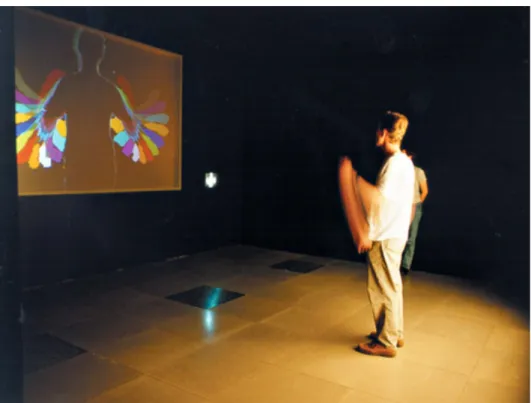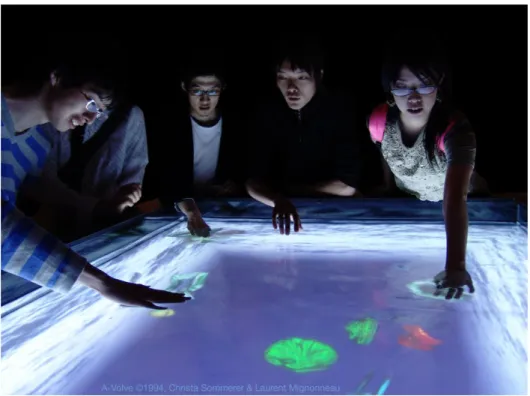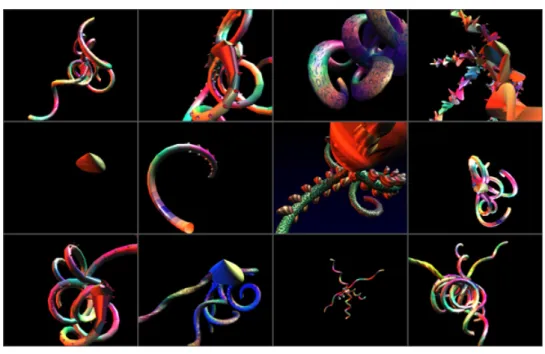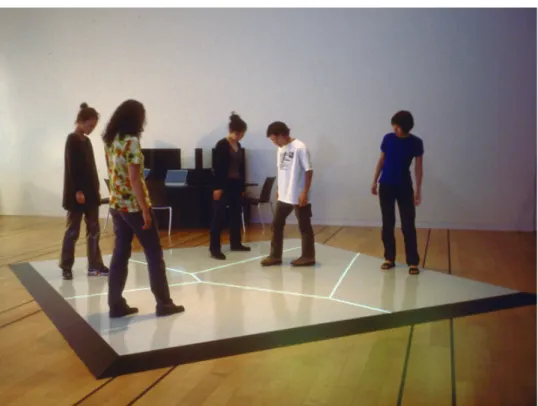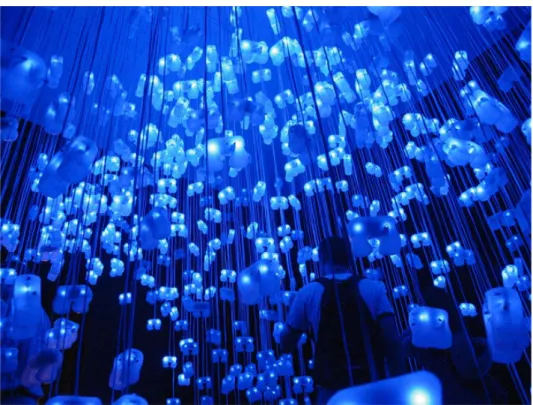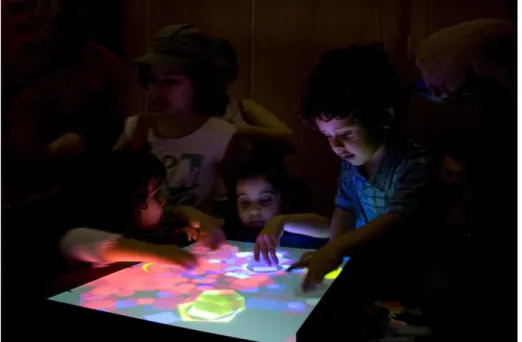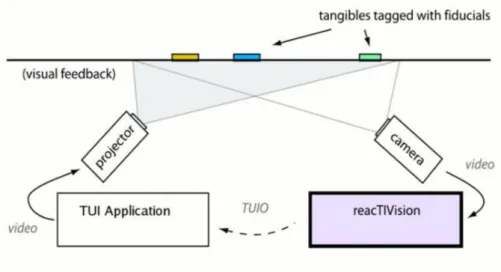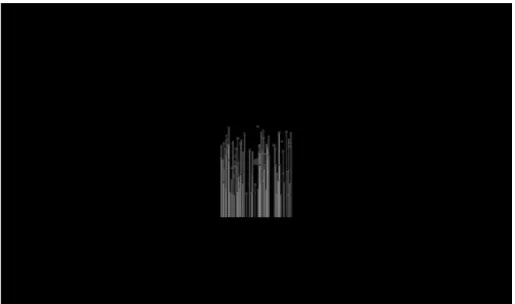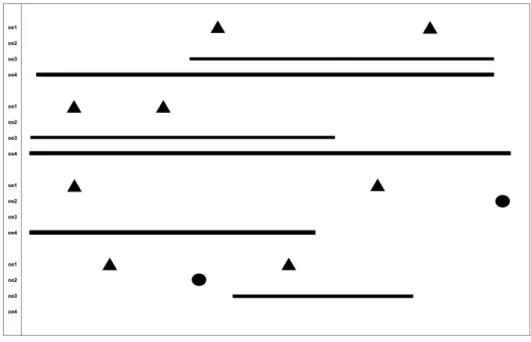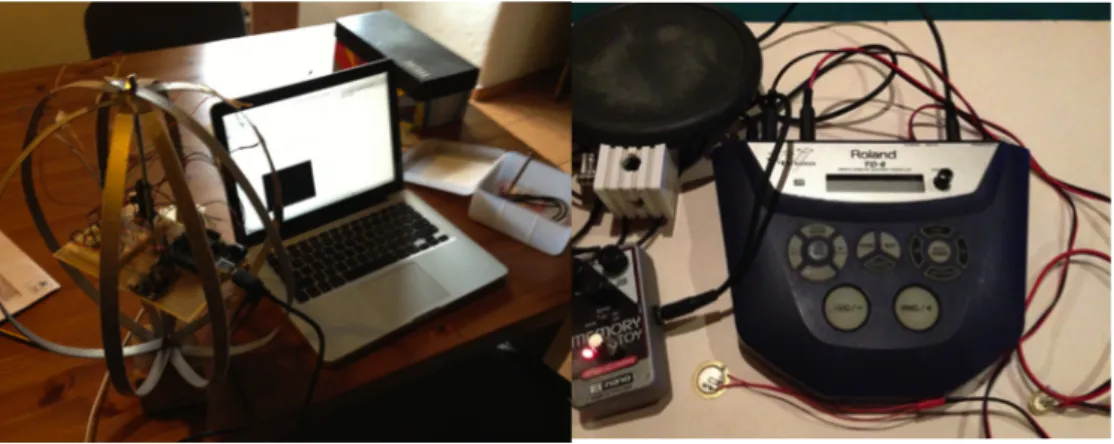UNIVERSIDADE CATÓLICA PORTUGUESA
ADAPTIVE INTERFACES FOR LIVE PERFORMANCE OF GENERATIVE GRAPHICS
( ARTE GENERATIVA: INTERFACES COMPORTAMENTAIS NA MEDIAÇÃO ENTRE IMAGEM E SOM)
Dissertation submitted to the Portuguese Catholic University in partial fulfillment of requirements of the Doctoral Degree in Science and Technologies of the Arts –
Computer Music by
Joana Ferandes de Carvalho Gomes
ESCOLA DAS ARTES December 2014
UNIVERSIDADE CATÓLICA PORTUGUESA
ADAPTIVE INTERFACES FOR LIVE PERFORMANCE OF GENERATIVE GRAPHICS
( ARTE GENERATIVA: INTERFACES COMPORTAMENTAIS NA MEDIAÇÃO ENTRE IMAGEM E SOM)
Dissertation submitted to the Portuguese Catholic University in partial fulfillment of requirements of the Doctoral Degree in Science and Technologies of the Arts –
Computer Music
By Joana Fernandes de Carvalho Gomes
Dissertation supervised by Professor Álvaro Mendes Barbosa
This Doctorate Research was partially supported by the Portuguese Science and Technology Foundation (FCT), trough the award of the Doctorate Grant reference
Abstract
While attempting to find new ways to create art, artists transgress the traditional notions of creativity and art. Computers start to have creative behaviors in which the artist conducts his work. Both, generative practices and interactivity have a special impact on the creation of Art and in its new relationships. Interactivity and generative processes can create a space for genuine innovative creative practices in art where the artwork is the result of collaborative work between computers and users.
Is our goal to express generative practices not as a static creative process, but instead as an iterative communication between system and interface/ interface and user. This collaboration between system, user and artist gains higher relevance through the creation of an interface that is capable of synthesizing these expressions.
In the process of identification of a new way of relating generative graphics systems and user/performer, an application for mobile devices was developed where interaction takes into account the need to express the generative processes through the interface, generating a greater connection between the three parties (generative system, interface system and user). This need comes from the generative system itself since it is semi-autonomous and is constantly undergoing modifications exhausted in any type of static and rigid interface .
Sliders and buttons take away the freedom of a system that aims to expand connections and collaborations, where the authoritarian act of
the user/performer overrides the choices of the system by imposing their own. ALIVEART proposes a new form of communication where the generative graphics interface adapts depending on the characteristics of an artificial living system. Thus, the parameters set by the system are modified on the interface showing only those that the user may interact. Over time these choices cause modification of the a-life as well as the interface. The result is a system that algorithmically, via sound inputs, draws graphics that are modified by an adaptive interface.
Rather than change the operation of the interface, we sought to create new interaction paradigms in which the user’s interference is revised by proposing a more conscious way to interact with artificial living systems.
Via a survey of three areas of expertise (designers, performers and user interface experts), ALIVEART was assessed. New areas of interest were identified that confirmed the necessity to implement interfaces that adapt to systems and users thus allowing new forms of relationships and creative processes in the creation of digital art.
Resumo
No processo de encontrar novas formas de criar obras de arte, os artistas conseguem transgredir as noções tradicionais de criatividade e arte. Computadores desenvolvem comportamentos criativos em que os artistas decidem exploram capacidades externas a eles para alcançar novas expressões artísticas. Ambos, práticas generativas e a interatividade, têm um impacto especial na criação da arte e nas suas relações. Nesta conjuntura, interatividade e os processos generativos são um espaço de práticas inovadoras, criativas e originais para a arte em que a obra é resultado de um trabalho colaborativo entre artista, computadores e utilizadores.
É o nosso objetivo demostrar que as práticas generativas não como um processo criativo estático, mas sim como uma comunicação que se repete entre sistema e interface / interface e usuário. Esta colaboração entre o sistema, usuário e artista, que ganha maior relevância através da criação de uma interface que é capaz de sintetizar todas estas expressões gerando uma nova visão artística que resulta dessa articulação.
Através de uma detalhada revisão bibliográfica conseguimos datar as primeiras modificações de paradigma que foram decisivos na criação dos conceitos que trabalhamos nos dias de hoje. Dos 60 em diante, a arte e os aspectos socioculturais sofreram mudanças muito importantes permitindo que os artistas rejeitassem as práticas artísticas tradicionais e que introduzissem novas ideias. Essas ideias mudaram a forma como os artistas produziram arte e até mesmo aquilo que era considerado arte. Artistas dos movimentos artisticos Fluxus e Arte Conceptual foram reesposáveis por criar uma clivagem ainda maior entre antigas e novas práticas através da introdução de ideias que são a base para a arte como
a conhecemos hoje. Essas ideias foram essenciais para gerar nos anos 90 o espaço em que os artistas por computador encontraram para explorar novas mídias na produção de arte.
Uma das maiores mudanças que ocorreram durante os anos 60 advém da obra de arte deixar de estar relacionada com o artefacto, passando a ser mais relevante as ideias e os processos relacionados com o ato artístico. Artistas conceituais começaram a expor as suas instruções para a construção de uma determinada obra de arte como sendo a própria obra de arte. Este processo de separação das práticas artistas e das técnicas, incentivou novas estratégias de arte e deu um novo significado para o papel do artista. O processo tornou-se o aspecto mais importante das práticas artísticas alterando por completo a relação entre arte e artista.
Com o uso do computador essas ideias ganham forma através da introdução de sistemas interativos (resultado directo da arte particiativa) e através da criação de comportamentos semiautónomos que surgiam das regras estabelecidas no computador. Muitos artistas contemporâneos desenvolveram tais obras de arte e foram capazes de criar um novo tipo de criatividade que emerge destas três entidades: o usuário, artista e sistema generativo. Apesar do computador permitir aos utilizadores novas formas de criar, muitas vezes verificamos que as estratégias utilizadas não conseguem desfrutar de forma completa da autonomia de sistemas externos devido a forma como se estabelece a interação. Em resposta, surge a necessidade de buscar uma nova forma de se relacionar sistemas gráficos generativos e utilizador/performer de uma forma que explorasse as capacidades dos sistema de vida articial dando-lhe realmente alguma autonomia sobre a sua condição. Optou-se por desenvolver uma aplicação para dispositivos móveis onde a interação toma em consideração a necessidade do sistema de se expressar através
do interface, gerando uma maior conexão entre as três partes (sistema generativo, interface e utilizador). Essa necessidade advém dos sistemas generativos serem semiautónomos e estarem constantemente a se modificarem, se esgotado num interface estático e rígido.
Sliders e botões esgotam a liberdade de um sistema que pretende ampliar conexões e colaborações, onde o ato autoritário do utilizador/performer aniquila as escolhas do sistema impondo as suas próprias. ALIVEART propõe uma nova forma de comunicação com sistemas de gráficos generativos onde o interface se adapta consoante as características de um sistema de vida artificial. Essa adaptação significa que os parâmetros definidos pelo sistema se modificam no interface mostrando somente aqueles que o utilizador pode interferir. Ao longo do tempo as escolhas do a-life vão modificando assim como o interface. O resultado é um sistema que através do som desenha algoritmicamente gráficos que são modificados através de um interface adaptativo.
Esta interface adaptiva apresenta ao performer os elementos visuais que podem ser controlados excluindo os que, naquele momento, são irrelevantes permitindo mais foco no ato performativo e permitindo que o utilizador/ performer seja capaz de uma maior imersão no sistema em si. Mais do que manipular parâmetros buscamos metáforas que sejam capazes de ampliar a comunicação entre mundo virtual e actual permitindo até criar uma ligação simbiótica entre os três elementos envolvidos.
Mais do que alterar o funcionamento do interface, buscou-se criar novos paradigmas de interação onde o próprio acto de interferência do utilizador é revisto, sendo proposta uma forma mais consciente de interagir com sistema artificiais vivos e consequentemente explorando mais profundamente as propostas dos sistemas vivos artificiais através
de tomam decisões ao definir a informação que é partilhada com o utilizador através do interface.
Através de testes realizados com especialista das três áreas que sustenta ALIVEART (design, HCI e performance) foi avaliado a adequação dessa proposta e definidos novas áreas de interesse confirmando a necessidade de implementar interfaces que se adaptam ao sistemas e ao utilizadores para expandir novas formas de relações e processos criativos na criação de arte digital.
Concluímos em nossos experimentos que tal tipo de interface Alcançou resultados importantes na promoção da colaboração e do compromisso do utilizador com sistemas generativos, promovendo uma interação mais dinâmica e fluida com um sistema que é, por definição, semiautónomo. Como que se espera das práticas generativas e interativa abordadas na revisão de literatura, ambas características foram muito importantes no processo de definição do conceito de criatividade. No desenvolvimento da interface de ALIVEART notamos que interface adaptável não só torna a tarefa para ambos os sistemas mas fácil como também muda o processo de criatividade em si, permitindo que o usuário defina e implemente num sistema externo à ele habilidades que promovam a criatividade.
Apesar dos resultados positivos obtidos com este primeiro protótipo conseguimos apontar novos caminhos de investigação que se desenrolam do trabalho aqui desenvolvido. É nossa proposta que se amplie as possibilidades de escolha do sistema, colaborando ainda mais com o utilizadores apostando nas escolhas do sistema para o desenvolvimento de novas formas criativas de gerar gráficos. Acreditamos também que técnicas como Music Information Retrieval (MIR) são de grande importância para esta linha de trabalho uma vez
que permitem que o sistema reconheça e se adapte mais livremente ao estilo musical de cada concerto.
Acknowledgments
Some people contributed substantially to this research and enabled my growth both professionally and personally.
I'll start by thanking my Professor and Advisor Dr. Álvaro Barbosa for his pragmatism and extensive scientific knowledge towards enabling the completion of this research. I also want to thank the Director of the School of Arts, Professor Laura Castro, the Sound and Image Coordinator, Professor Luis Gustavo Martins, and the Director of the Doctoral Program in Science Technology and the Arts, Professor Paulo Ferreira-Lopes. I also want to thank my colleagues and former teachers Helder Dias and Cristina Sá who played a substantial role in the development of my interest in interactive arts.
To my classmates with whom I shared the office and many good times, André Baltazar, André Perrotta, João Cordeiro, Mailis Rodrigues e José Vasco Carvalho - Thank you!
I want to also thank all the experts who participated in the questionnaire allowing me to gather important data from the mobile app ALIVEART and from which I was able to draw important conclusions during this investigation. Thank you, Vinicius Vecchi for collaborating in the migration of the code to c++.
On a more personal side, I would like to thank Helena Figueiredo, Maria João Neves, Ana Luisa Santos, Joana Pestana e Sandra Ferreira for their friendship, affection and for giving me much needed support in my difficult moments that unfortunately coincided with the development of this thesis.
A special Thank you to my family, Maria Luisa Gomes and David Gomes who have always given me strength to continue and for their unconditional support, Without you, none of this would have been possible.
TABLE OF CONTENTS
ABSTRACT ... I
RESUMO ... III
ACKNOWLEDGMENTS ... VIII
LIST OF FIGURES ... XIV
LIST OF TABLES ... XVII
ACRONYMS ... XX 1 INTRODUCTION ... 1 1.2 MOTIVATION ... 3 1.3 OBJECTIVE ... 4 1.4 METHODOLOGY ... 5 1.5 MAIN CHALLENGES ... 7 1.6 THESIS STRUCTURE ... 8
2 HISTORICAL SURVEY ON GENERATIVE ART ... 10
2.1 DEFINITIONS ... 12
2.2 FROM ANALOG TO DIGITAL ... 16
2.3 SOME GENERATIVE METHODS ... 20
Complex vs. Simple ... 20
A-‐Life ... 23
2.4 DIGITAL CREATIVITY AND A-‐LIFE ... 26
2.5 CONCLUSIONS ON GENERATIVE PRACTICES ... 29
3 INTERACTION AND INTERFACES FOR ART ... 31
3.1 FORMULATING THE CONCEPT OF INTERACTIVITY IN ARTS ... 32
3.2 THE INTERFACE ... 37
3.3 MOST RELEVANT EXAMPLES OF INTERACTIVE ARTWORKS ... 40
3.3.1 VIDEOPLACE (1974) ... 42
3.3.2 A-‐Volve (1994) ... 44
3.3.4 Boundary Functions (1998) ... 48
3.3.5 Bion (2006) ... 50
3.3.6 Final Considerations about the Projects ... 51
3.4 A NEW APPROACH TO ADAPTIVE INTERFACES ... 52
3.4.1 Main concepts and applicability ... 53
3.4.2 Adaptive vs adaptable ... 56
3.5 CONCLUSION ON INTERACTIVITY ... 58
4 PRELIMINARY EXPERIMENTAL DEVELOPMENTS ... 60
4.1 UNTITLED* ... 63
4.1.1 The system behind Untitled*: ... 66
4.1.2 Establishing the interaction ... 69
4.1.3 Hand movement ... 71
4.1.4 The Objects: ... 73
Generators: ... 76
Tools: ... 79
4.1.5 Conclusions about Untitled* ... 80
4.2 THE GRINCH ... 81
4.2.1 The ensemble ... 82
4.2.2 The Live Performance ... 84
4.2.3 Instruments ... 87
4.2.4 The visual system: The a-‐life, the sound, aesthetic and the interaction .... 91
4.2.5 Using the sound: ... 92
4.2.6 Aesthetics ... 93
4.2.7 The interaction: ... 100
4.2.8 Conclusions about The Grinch ... 102
4.3 2 + N ... 104
4.3.1 Interaction ... 105
4.3.2 The System ... 110
4.3.3 The graphics: ... 112
4.4 “FANTASIA SOBRE FANTASIA “ ... 113
4.4.1 The graphics ... 114
4.4.2 The Orchestra: ... 115
5 ALIVEART: A FRAMEWORK FOR LIVE ADAPTIVE INTERACTION FOR
GENERATIVE MEDIA ... 121
5.1 DEFINING THE INTERFACE ... 122
5.1.1 Defining the space of interaction ... 127
5.1.3 Controlling the Parameters ... 131
5.1.2 Aesthetical choices ... 134
5.2 A-‐LIFE : CHARACTERISTICS AND FUNCTIONING ... 137
5.2.1 Basic knowledge about the a-‐life ... 140
The Ecosystem ... 140
Population ... 142
5.2.1 The individual ... 144
Reproduction ... 145
Movement ... 148
5.2.2 Graphical representation of the System ... 149
5.2.1 Sound ... 151
5.2.3 The Parameters ... 158
Resources: ... 159
Movement ... 161
Zoom ... 163
Color of the Particles ... 165
Background ... 166
5. 3 CONCLUSIONS ABOUT ALIVEART ... 167
6 PROOF OF CONCEPT PROTOTYPE: ANALYSES AND RESULTS ... 170
6.1 CHOOSING THE TESTERS ... 170
6.2 DESIGN OF THE SURVEY ... 171
6.2.1 Characterization of the User ... 172
6.2.2 Technological Aspects ... 173
6.2.3 Generative Live Graphics ... 174
6.2.4 ALIVEART: the app ... 175
6.3 INSTRUCTIONS GIVEN TO THE USERS ... 176
6.4 SURVEY EVALUATION ... 179
6.4.1 Testers Information and Background ... 179
6.4.2 ALVEART Evaluation ... 186
6.4 CONCLUSIONS FROM THE SURVEY RESULTS ... 202
7 CONCLUSIONS AND FUTURE WORK ... 204
7.1 FINAL CONCLUSIONS ... 204
7.2 FUTURE WORK ... 207
8 REFERENCES ... 210
9 APPENDIX A ... 218
List of Figures
Figure 1 VIDEOPLACE picture taken from:
http://thedigitalage.pbworks.com/w/page/22039083/Myron%20Krueger (22/10/2014) ... 42 Figure 2 A-volve image taken from
http://musicasc.com.br/noticia/mercado- udesc-recebe-artistas-de-renome-internacional-para-palestra-sobre-arte-ciencia-e-tecnologia/ (22/10/2014) ... 44 Figure 3: Different outcomes generated by the system. Taken from http://www.generativeart.com/on/cic/papersGA2004/3.htm (22/10/2014) ... 46
Figure 4: Picture take of Boundary Functions
fromhttp://www.snibbe.com/projects/interactive/boundaryfunctions/ (22/10/2014) ... 48 Figure 5: Bion taken from http://www-symbiotic.cs.ou.edu/projects/bion/ (22/10/2014) ... 50 Figure 6 UNTITLED* during exhibition at Serralves 2009 ... 63 Figure 7 Image of the final objects ... 73 Figure 8 reacTIVision from reacTIVision: a computer-vision framework for table-based tangible interaction (Kaltenbrunner & Bencina, 2007). ... 76 Figure 9: Image taken during the performance example from “Drawing 1” .... 81 Figure 10: Graphical score by José Alberto Gomes ... 86 Figure 11: Graphical score by José Alberto Gomes ... 86
Figure 13: Scheme illustrates the input information (sound and user interaction) that is received by the generative system, retrieving the generative graphics. ... 96 Figure 14: Image of the output of Drawing 2 ... 98 Figure 15: Image of the output of Drawing 3 ... 98 Figure 16: Image of the output of Drawing 4 ... 99 Figure 17: Image of the output of Drawing 5 ... 99 Figure 18: Image taken from the graphics during the exhibition at Culturgest Lisboa ... 104 Figure 19: in this exhibition beside sound input and the interaction of the performance, were also received messages via OSC that were sharing data from the generative process that were producing the music. ... 108 Figure 20: Picture taken during the performance at Casa da Música ... 113 Figure 21: typical interface information flow ... 125 Figure 22 Traditional Adaptive User Interface ... 126 Figure 23: proposal of an adaptive user interface that can adapt both to the user and the a-life system. ... 126 Figure 24 First sketches of interface according to number of parameters and an example when one parameter is activated. ... 130 Figure 25 Initial representation of the a-life system without sound input - iPad version ... 141 Figure 26 Same situation described in previous figure - iPhone version ... 142
Figure 27 Sociability and energy required to procreate. If those characteristics allow the individual to mate, will be tested if the mate is from a different gender, the amount of resources in the cell, time from reproduction and factor. ... 146 Figure 28 Excess of resources in the cell will increase the change matting ... 147 Figure 29 Movement of each individual ... 149 Figure 30: result of the graphics during experimentations with Ryoji Ikeda’s album Matrix (99-00) Disc 2 ... 154 Figure 31 result of the graphics during experimentations with Fluvio Salamaca’s songs (Adiós, corazón (1957), Yo tengo un pecado nuevo (1958) and Quereme corazón) ... 155 Figure 32 No Sound input but the system will continue to generate graphics. Maximum Zoom In (controlled by the interface) ... 156 Figure 33 Making the decision in which direction is made the next zoom in . 157 Figure 34 Excerpt of the code where is defined the average of the sound amplitude from the FFT. The number of peaks is used to determine the color of the individuals ... 158 Figure 35: Here’s an example of the selection of the parameter movement. The area of the parameter selected is darker. ... 162 Figure 36: The user can choose to make the back ground darker. By doing that the selected area gets even darker. ... 167 Figure 37: ALIVEART when the interface is presenting four parameters (color, resources, background and movement). Users can select more than one parameter at a time. All the selected areas get darker. ... 177
List of Tables
Table 1 Graph that reveils different systems going from order to disorder and passing through complexity. (Flake, 1998) ... 21 Table 4 Areas of expertise of testers ... 180 Table 5 Percentages of testers that use iPhones and iPads ... 181 Table 6 Percentage relating to users and their habits of consumption apps ... 182 Table 7 Percentage of users that have ever bought apps dedicated to art expression ... 183 Table 8 Experience with life graphics for concert setups ... 184 Table 9 How well do the testers understand the meaning of generative graphics
... 185 Table 10 Percentages of how well the testers understand the meaning of what A-Life ... 185 Table 11 Experience of testers in different concert setups ... 186 Table 12 the percentage of individuals based on the time they spent in his first approach to the app. ... 187 Table 13 percentage of users about ease of use of the app ... 188 Table 14 Users understanding of the goal of the app ... 188 Table 15 The user’s understanding of the interface ... 189
Table 16 percentage of how well the testers understood his effect over the system ... 190 Table 17 percentage of users that felt the graphics developed were expressive.
... 190 Table 18 How the user felt about the graphics ... 191 Table 19 Percentage of users that were able to achieve interesting graphics during the time he/she was exploring the app ... 192 Table 20 the users ability to perceive the action of the a-life system ... 193 Table 21 Percentage of testers that found it easy to read information displayed on the screen ... 194 Table 22 – the importance of overlapping the information on the screen ... 195 Table 23 Percentage of users that was able to identify that color change depending on the sound ... 196 Table 24 Percentage of users that was able to identify that zoom difference depending on the amplitude of the sound ... 196 Table 25 Percentage of users that was able to identify that interface was changing according to the parameters ... 197 Table 26 Percentage of users that was able to understand that selecting areas was influencing the system ... 197 Table 27 Percentage of users that felt that the amount of time they selected an area of the interface changes the input information to the system ... 198 Table 28 Percentage of users that could feel the a-life reflection on the parameters shown in the interface ... 199 Table 29 General evaluation by the testers of the mobile app ALIVEART ... 200
Table 30 Relation between the average of the overall evaluation of the app and the time spent by users experimenting the app ... 201 Table 31 Context in which users plan to user the app again ... 202
Acronyms
AI: Artificial Intelligence A-Life: Artificial Life CA: Cellular Automata
DMI: Digital Music Instruments FFT: Fast Fourier Transform GA: Genetic Algorithm GUI: Graphical User Interface IUI : Intelligent User Interface MIR : Music Information Retrieval OSC: Open Sound Control
TUI: Tangible User Interface VR: Virtual Reality;
1 Introduction
From the 60’s, art and social cultural aspects underwent important changes. Artists rejected the traditional art practices and introduced new ideas which changed the way they produced art and what was considered art. Fluxus and Conceptual Art caused an even bigger cleavage between the new and old practices by introducing ideas that are the basis for art as we know it today. These ideas led to the use of new media and computers in art production in the 90’s.
One of the biggest changes that happened during the 60’s was the idea that art wasn’t about the artifact, but about its ideas and process. Conceptual artists started exposing their instructions for the construction of a given artwork as the artwork itself. This process of separating the artist practices from the technical ones encouraged new art strategies and gave new meaning to the role of the artist. The process became the most important aspect of artistic practices.
In parallel, the idea of participation also emerged, in which the final artwork was not presented to the audience but instead was done collaboratively between the artist and the spectators. Many Fluxus artists engaged with their audience and constructed the artwork. These two ideas emphasize process over artifact but as we are going to see, they are the pillar of support of two very important contemporary practices: generativity and interactivity.
Through the introduction of interactive computer systems, these ideas gain form. Interactive systems coupled with semi-autonomous behavior based on rules established by the Computer are a step further over participation. Many contemporary artists developed such artworks and
were able to demonstrate a new type of creativity that emerges from the three entities: the user, the artist and a generative system.
As a result, the relationship between artwork and artist changed. Art became interactive and gained the ability to change on its own. This changes reflected about the process of using this strategies (interactivity and generative processes) and not about the technical aspects involved in the creation of the artwork.
Many artworks used interactivity and generative processes to make the user rethink his own characteristic, others embraced these tactics to produce new aesthetical paradigms, but all had the same purpose of creating in the machine a semi-autonomous system that interacts with the audience producing an engaging experiences.
It is important to consider that many of these systems are trying to adapt to the user in a variety of possible ways (including by learning from by their previous behaviors or by analyzing their emotions through effective computing) but normally we can find artworks that are actually adapting to the generative system. This issue becomes highly relevant in live performances.
From our experience, it became clear that this adaptability from the interface in which is considered that the interaction is not happening to a static system, but instead, is happening to a generative one, is enhancing not only the system possibility of better expressing itself but is actually enhancing the performative art and the creative process created by the three entities.
From a series of experiences, we are able to propose a different way to interact in live performance, especially for generative graphics that react to sound input. As a result of this research, we developed an app for iOS mobile devices
ARTALIVE is a system that triggers generic graphics based on musical input. Depending on the features of the music, the graphics develop algorithmically through an artificial life system.
The behavior of these generative graphics can also be controlled by an interface that introduces another level of performance (beyond the musical performance) controlled by the visual artist. However, this interface also adapts to the musical features and the development of the a-live system.
This adaptive interface presents the visual performer with elements that can be controlled excluding the ones that are irrelevant at that moment, allowing more focus on the performative act.
By the development of such an interface, we hope to create innovative ways to develop interactive generative graphics. We hope that by changing the interaction we can change the relationship between user and the system and find a new space for collaboration where the creative act is shared in a fluid and comfortable way.
1.2 Motivation
From previous experience gained from developing generative systems for art, it was possible to verify the potential of such practices. Interesting innovative patterns emerged and new graphical aesthetics were discovered in the new systems.
During this time, we were able to develop a series of generative artworks, which ranged from interactive art installations to live performance. Considering the multiple possibilities of such practice, we
applied our efforts in transgressing the limits of the digital by giving life to virtual entities. In our work, this life always wishes to get a form on this side of the window and be able to transgress its own virtuality. Even though the characteristics and necessities of an interactive installation and a live performance are very different, we felt that in both cases, there was sufficient complexity in enabling the systems to express themselves. We couldn’t actually fell the a-life system interfering in the actual world given it is normally badly expresses in the interface.
This inability to fully transgress the virtual into the actual world led us to believe that we weren’t taking full advantage of capacities of such practice. Through all the work developed, we felt that even though generative art was a branch of artistic expression capable of expanding human capacities, this transgression is only going to be possible if we are really able to overstep these limitations of the interface creating ways to represent such systems.
1.3 Objective
Given the motivations identified, the objective of this research is to understand how we can establish a communication that is not only concerned in the characteristics of the user (here the research is more developed) but also concerned with the characteristics of the generative system. In recent times, the interface is constantly being developed to better understand its user, by learning from his previous choices or even by reading his emotions through Affective Computing. However, the current technology is not geared towards adapting the system.
Although user adaptive interfaces are a very important field of work, we have to realize that when we are dealing with a generative system, we also need to take into consideration, the system and its behaviors. We believe that the only way to really fulfill the goals of the generative art is by ensuring that the entire work in developed in a way that the system is adapting to both the living system (humans) and the virtual entities generated by the generative system.
Hence, the objective of this research is to find ways to use the maximum potential of the generative art by allowing the system to also influence the interaction. The goal is to develop an interface that is capable of adapting not only to the user but to the A-life system as well.
1.4 Methodology
During the research, we followed seven steps. Every one of them was essential to achieve the conclusions described in this document. They are:
1) Research problem formulation; 2) Literature review;
3) Preliminary research experiments; 4) Formulation of the objectives; 5) Experimental research project; 6) Analyses of the results and 7) Conclusions and future work.
As described in the previous sections, based on a series of works developed in the years prior to this research, we felt that interfaces for live performance weren’t able to convey to the performer, the adequate characteristics when dealing with generative systems. Thus, we dedicated ourselves to identifying literature by other artists and researchers that could help us identify the best possible solution.
We dedicated ourselves to the study of generative art and interactivity, not restricting ourselves to live performances but addressing all areas where both these practices are prevalent. Through these efforts, we were able to comprehend contemporary art practices and creative processes and were also able of enunciate the state of the arts of both branches. After reading and analyzing some proposals (that until today are still very limited), we performed a set of preliminary experiments to collect important information about our goals. From these experiments, we were able to formulate a set of elements that had to be necessarily represented in the proposed system.
Based on data extracted from the experiments, we were able to formulate the experimental research project (ARTALIVE). We opted for empirical research in which we distributed the developed mobile app to a set of 15 people. To obtain expert opinion, we selected only Performers, User Interface experts or Designers. Each one of those users was provided the app on their devices along with a brief description of the work and instructions. They were able to try the app for a whole week, followed by inquiry (see in APPENDIX A).
The results from the inquiry were populated into tables to conduct statistical analysis. The results support the proposal.
1.5 Main challenges
Some of our main challenges during this research were:
1) Achieving a balance between autonomy of the system and user interference, reinforcing the idea that the user is just interfering with the system, instead of changing the parameters as the user pleases or without making the user an irrelevant part of this system; and
2) Sound analysis.
An area of focus in this research is to determine means of using live system simulations to create interesting graphics. The key difficulty was not in achieving an appealing aesthetic but the development of something autonomous that the user can interfere without disrupting its autonomous nature. In most cases when dealing with generative systems, when the user interferes, he is actually transforming the results of the world in a very dictatorial way. Instead, we wanted to ensure that when user selects any parameters shown on the interface, he is only stimulating the system to change his trajectory. This change may or may not modify the system trajectory. Achieving this balance was one of our main challenges.
Another challenge that confronted us in the development of the first version of the app was with sound analysis. We wanted to ensure that different sound sources had different impact on the graphics since different sounds differ in their qualities. While working with laptop users and orchestras, we realized that sounds generated by different devices had very different quantity of harmonics. This identification of various sounds was harder than we first thought, leading us to significantly simplify the sound identification process.
1.6 Thesis Structure
This thesis has been constructed to enable the reader to easily navigate and understand the most relevant concepts and ideas related to this research.
Chapter 2 identifies generative art practices through the explanation of some key historical points including furthering the understanding of cultural and social changes in the 90’s with the introduction of computers in the art practices. These changes had social impact by renewing the idea of artwork and the role of the artist.
Chapter 3 is an analysis of interactivity. We defined the interface as the most important element through which it is possible to establish communication with computers. We reviewed the evolution of the most relevant artwork interfaces and synthesized the ideas reflected in chapters 2 and 3.
While chapters 2 and 3 focus on literature review, the following chapters are dedicated to the experimental process. Chapter 4 analyzes four experiments developed during this research. Each experiment allowed us to identify the considerations when developing an adaptive user interface for live performance of generative graphics.
Based on discoveries per the experiments identified in chapter 4, we formulated a proposal describing the characteristics of the interface described at chapter 5.
Based on a working application, a series of tests were performed and carefully analyzed. Analysis of the data helped us deriving conclusions
as well as the identification of future work to be done in this field ( chapter 6 and 7).
2 Historical Survey on Generative Art
“ Generative art is about the organic, the emergent, the beautiful, the imprecise, and the unexpected” (Pearson, 2011)
In generative art, the artist sets tasks to the machine, and establishes in the machine an extension of him/herself. Those extensions can be biological or psychological (McLuhan, 1994) (Benjamin, 1970) once the medium can establish actual physical extensions or it can allow the user access different possibilities in the artist him/herself. It provides a semi-autonomous system (Todd & Latham, 1994) (Whitelaw, 2004) where the artist can be the agent that selects or gives a program the ability to execute a selection through the rules he/she builds-in.
The relationship between art and science has always been very close and generative art is no exception valuing and bringing together these two domains. From principles of biology, where we can understand evolutionary concepts and selection principles (Dawkins, 2006), and the acquisition of the external process of the human comprehension, it allows the creation of artificial replicating structures that don’t belong to the human domain.
Generative art is a branch of artistic practice that uses resources from biology, mathematics, physics and other scientific fields for its simulations such that are able to generate new paradigms that until then were beyond the artist’s reach.
New characteristics such as learning, adaptation and mutations are typical of those systems. Normally, the most adapted ones perpetuate the skills more valuable and desired for the system in that moment (Holland, 1992).
The rules are the algorithms generated by the artists and the rules applied are the parameters that shape the behavior of a certain individual, population and habitat. But like in living beings those rules can be transgressed and the process reacts in a lot of different ways. This unpredictability, typical of complex systems (Gouyon, Barbosa, & Serra, 2009), gives the artist the possibility of action and results that are beyond the ones he is capable of comprehending through his natural systems of perception: vision, touch, smell, etc.
Thus, the processes and the relations between humans and machines become closer. The interactions become more fluid and adapted. The intelligence of some of those systems allows that each individual gets better responses to his/her/its and more evolved and optimized actions. The changes due to the introduction of the computer in art practices led to significant changes in the contemporary world. These changes influenced important cultural aspects such the definition of artist and self. New relationships between computers, user and artists emerged opening the elements required for the development of important artworks.
Before digital media, Ben Laposky and John Whitney highlighted the capabilities of generative art. In digital media, tools like Processing (Fry & Reas, n.d.) and OpenFrameworks (Lieberman, Watson, & Castro, n.d.), brought artists and designers together in developing such projects. Artists popularized this art through graphic works (Joshua Davis and
Casey Reas), sculptures (Marius Watz) and interactive
(Sommerer & Mignonneau, 1999a) (Sommerer & Mignonneau, 1998), Golan Levin and Zachary Lieberman, Karsten Schmidt). The generative processes most often are not exposed to the eye of the beholder. Often these processes are embedded in the form of interaction with the artwork. Pattie Maes, Christa Sommerer, are artists who have created artworks based on generative processes.
2.1 Definitions
“Some works pursue an absolute, self-sufficient autonomy; others use an appearance of autonomy to provoke empathy or raise questions about human agency” (Whitelaw, 2004)
The generative art is an art form widely known within contemporary arts and has gained increasing presence in the art world. Featuring works in several areas, the generative art is still very poorly understood by most people, mainly because it is so comprehensive and therefore its efficacy can be very difficult for a group meeting with very narrow parameters.
What is generative art? According to Philip Galanter “Generative art refers to any art practice where the artist uses a system, such as a set of natural language rules, a computer program, a machine, or other procedural invention, which is set into motion with some degree of autonomy contributing to or resulting in a completed work of art.” (Galanter, 2003) Galanter’s definition is the most accepted. Galanter states that the difference between a generative artwork and any other
computer program is in the artist’s decision to cede part of its control over the piece to an external system.
The external influence of such practices and the rule based organization of this type of art is founded in the 60’s artists. In conceptual art (Alberro & Stimson, 1999) the artist transfers the function of the construction of the object and decides to give instructions. Just like in the early days of conceptual art, where artists like Yoko Ono and Robert Barry defined letters with instructions as their artistic works, a generative artist define rules that are implemented by the computer. In fact the term generative art is a definition that cannot be only related to technique (McCormack et al., 2014). It takes more than the form and rules to “build” the art object: it is the decisions of the artist on the results generated by the algorithm developed. One of the difficulties that emerge when trying to define this type of practice is the fact that generative processes can be used by designers, artists, architects, scientists, etc, creating a large number of varied outputs. This comprehensiveness causes complexity in grouping the various elements. The variety of possibilities causes elaborate questioning by the spectators. The possibility of uniting such diverse work in one branch, lead Galanter to also realize that: “what generative artists have in common is how they make their work, but not why they make their work or even why they choose to use generative systems in their art practice”. (Galanter, 2003)
“Contemporary new media artists use a-life in a variety of contexts, to a variety of ends: some works pursue an absolute, self-sufficient autonomy; others use an appearance of autonomy to provoke empathy or raise questions about human agency. Many of the artists using
a-life strive for a supple, engaging form of interactivity and a work that draws the audience into an active relationship; others present aesthetic artifacts that arise through their own intense engagement with a-life processes.” (Whitelaw, 2004)
These types of work played a significant role in the current definition of the role of creator / artist. While developing the code that generates the construction of the work, the artist’s role is no longer direct and is quite distanced from the final work. As these systems gain their own life, the artist ends up losing total control over the subject, contrary to what was happening, for example, in more traditional forms of painting or in any other more traditional artistic technique.
“Generative art redistributes traditional notions of authorship and intention, introducing autonomous processes and agents and allowing us to appreciate the systemic aspects of contemporary art production, exhibition and consumption from an illuminating perspective.” (McCormack et al., 2014)
They produce, moreover, the small contours and surprisingly unpredictable results giving a special glow to the final object. The possibilities beyond human perception plus a few random acts are some of the reasons why these kinds of pieces expand (rather than reduce) the role of the artist. By introducing randomness the artist is also introducing humanizing art because it destroys the stiffness typical of computer programs
“Randomness is often used to “humanize” or introduce variation and imperfections to an underlying rigid, deterministic process, as when a sequencer program plays back a musical score with slight random timing variations.”(McCormack et al., 2014)
The artist gives life to something that has a relative autonomy, which allows the construction of an object within the parameters set. Despite the artist’s distance from the work, he is the one that defines which images are to be presented to viewers. His distant perspective, almost like a god over his world, allows you to see it and understand it, permitting the selection for its best results. Despite the author’s role to delegate tasks to the “machine”, it ceases to have the leading role for the end result. In the case of digital arts such software becomes a kind of performative extension of the artist (Stelarc, 2007).
Another issue that causes some controversy over the generative art is the interest declared by some artists to do work where the only concern is aesthetics. The beauty in contemporary art was eventually perceived as an empty resource and devalued. The generative art found in the roots of pop art combined with electronic music led to the possibility of creating objects where the primary purpose is aesthetics. Generative art looks for natural forms and harmonies - where there is a return to nature or “nature like” approaches. Already Galanter said, “the universe itself is a generative system.” (Galanter, 2003) Some pieces end up falling in the mistake of becoming “Art of screen savers.”
Each generative work piece is unique for each performance. Artists from the 60’s such John Cage always incorporated such features in their
work, allowing a state of constant remaking / rethinking of the work. Despite the work being executed a thousand times, it always takes a new form. Everything depends on the purpose of the artist.
2.2 From Analog to Digital
The generative art is therefore a very broad field of art. Its main feature is using mechanisms external to the artist to achieve partly autonomous tasks following a set of rules defined by the author. Such concepts are not new. We can see the use of generative processes already for a few decades. Some works, despite being about 40 years old have results very close to generative digital art created in recent times. The contributions of major contemporary artists, Ben Laposky and John Whitney is paramount as they are considered the “fathers” of generative art for digital artists. Although many earlier artists (from Minimal, Conceptual and Fluxus) also developed some generative ideas, John and Ben were the first artists to really create art with this purpose.
The artist Ben Laposky (1914 - 2000), born in Cherokee, Iowa, was a mathematician, an artist and a pioneer in computer use in artwork. He was responsible for creating abstract images during the 50’s. In his first experiments he used a device called analog oscilloscope Cathode Ray Tube (CRT). His work, called “oscillons,” were beautiful mathematical curves based on the waves used in analog computers. The analog computers were first used in the 20’s and were able to perform calculations much faster in a very short time. The technique for building the code was a continuous variation of current allowing calculations in “real time” (unlike the technique used today by digital computers that makes use of finite signals). In the 40’s, analog computers began to be
replaced by digital due to their affordability. The images produced were photographed, resulting in an interesting work that was both aesthetic and technical strong. It became an icon for those who appreciate the generative art because images were organic, elegant and yet simple. Another very important example is the American animator John Whitney. He and his brother James started in the 40’s to study moving images, working on that throughout his life. They managed to combine success in commercial work with more experimental work. One of the best-known works was the introduction of the film “Vertigo” by Alfred Hitchcock. In the 60’s John formed a company, which specialized in making computer animations made for commercial purposes, an innovative strategy while still using an analog computer. In 1966, he began working on digital computers in residence at IBM that lasted three years. It was during his entire career as a constant innovator that led to increasing levels of complexity and to achieving what he called “harmonic progression.”
Both these artists were extremely important for the development of generative processes, as was the potential they identified that charmed digital artists. The way we studied the movement and behavior of the particles was also essential in the study of visual processes generated through generative systems. Both, John Whitney and Ben Laposky are important references; especially for artists who seek proceeding harmonics based particles.
With the advent of computers, the generative processes emerged in different art practices. Artists like John Maeda, Marius Watts, Golan Levin, Zachary Lieberman, Ben Fry and Casey Reas, Joshua Davis and many more were responsible for popularizing it.
John Maeda and his colleagues in the Aesthetics + Computation Group (ACG) were the first to advocate the use of computers as a tool in
creating objects of art and design. At that time many argued that the computer processes distort, easing through the copy-paste and other techniques, the creation process and thus generating failures caused by lack of process, intensity and rigor. Contrary to what the analog purists defended (including very prestigious graphic designers such as Paul Rand) that the computer brought to the arts important development that modified the processes of creation, John Maeda managed to make many of his students important artist, making them relevant in generative and interactive practices. They include: Golan Levin, Casey Reas and Ben Fry.
Marius Watz (Watz, n.d.-b) is a renowned creator of pieces in the area of generative art. He began working with software (to create visualization with code) in his early 20s after taking up a course in computer graphics. With the computer’s graphical and computational ability, he began to develop projects for Raves while doing design projects. Working in different media, Watz left his mark on generative art’s digital features for his aesthetic choices and their presentations in large formats (such as presented in Sao Paulo at the center “Itaú Cultural on July 18, 2006). Marius is the symbol of new artists who work with the new brushes of the digital age. While in some projects, he used sound as source of data, in others he appropriated data from the government to feed his system. In “Drawing Machines 1-12” (Watz, n.d.-a) Marius shows the flow of information in the server of the Norwegian government, distinguishing between micro and macro structures of information transfer. The result is a constantly changing construction with a visual result in 2D images. This project was developed in Odin, a public space, lasting two years.
Particularly interested in systems creation and manipulation of sound and images, Golan Levin created performances and innovative digital systems through dialogues between man and machine. He and his staff
created highly innovative and aesthetic works, which went beyond the expected boundaries and interlinks of digital media.
A renowned artist, through the creation of many interactive and engaging works, Golan is responsible for making generative art a little more tactile and fun. With several recognized works, Levin created projects that go beyond the aesthetic. Based on extremely complex interactive processes, the artworks are transmitted to the user in a straightforward manner, without the need for much explanation.
Golan created projects that fulfilled all the vital aspects of a project. He is also known for his collaborations with famous artists such as Zachary Lieberman and Fry (among many others).
A 2003 performance entitled Messa di Voce (Levin, n.d.), which is a collaboration of Golan Levin, Zachary Lieberman, Jaap Blonk and Joan La Barbara, uses speech, shouts and music generated by two opera singers to create interactive visualizations. With an extremely interesting result in terms of communication between performers, this system is a reference in the field of art. Inspired by the relationship between the song lyric (from which is derived the name Messa Di Voce, a name given to a singing technique where there is a gradual crescendo and decrescendo always in the same pitch) and visual creation, the performers create a variety of particles ranging in terms of size and movement, which can then be changed again according to the settings of the artist on the forms previously created. During the performance artists were able to create different visual representations. This project resulted in an installation presented later also called “Messa di voce”. Casey Reas, well known designer and artist is one of the creators of Processing (programming software for artists) and one of the pupils of John Maeda. He studied design at the University of Cincinnati, which
he left for MIT where he studied with Maeda and met his co-worker Ben Fry.
His work is based on the construction of art objects by algorithms. Currently his works serves as reference to works of Conceptual Art such as Sol LeWitt, searching for concepts developed by the vanguards of the 60s as minimalism and conceptualism. With Structures (2004) (Artport, n.d.) he relates software art and conceptual art and arises the question: “Is the history of conceptual art relevant to the idea of software as art?” Having built three possible structures, Reas offers new interpretations. His colleague Ben Fry, on the other hand, explores generative practices in data visualization, resulting in new forms of data presentation.
Some important artworks are analyzed in chapter 3 for example, Interaction and Interfaces for Art. We will analyze this later because it is important for us to have a more detailed account of generative art that takes particular care in its interfaces. These interactivity characteristics are taken into account if they enhance the generative process by expanding on the concepts being developed here. Christa Sommerer and Laurent Mignonneau, Karls Sims, Kruger and others are a few artists, whose work will be elaborated upon later.
2.3 Some Generative Methods Complex vs. Simple
Although we discussed in the previous sections that generative art is not about technology or technical aspects, but about its process, it is relevant to this work to identify some of the strategies. We would like to emphasize that our approach in this thesis is dedicated to the use of generative practices specifically in Interactive Digital Arts.
To begin, we will distinguish complex and not so complex systems (chaotic and order). These concepts are important to understand the different degrees of autonomy of our generative system. In this description, we don’t intend to qualify either of them.
While simple systems normally have few components and their interactions generate a predictable response, complex systems have much higher number of elements and their interactions produce emergent characteristics (Burraston, 2007). In reality, we know that complex systems are the result of the interactions between simple systems in which unpredictable behaviors emerge.
Lets think about two concepts: something completely random (chaos) and something very organized (order). Both of them are considered simple systems because when we analyze a section of their behavior, we can relatively easily find its pattern (completely inexistent or extremely defined) (Galanter, 2003).
On the other hand, in Complex systems, the pattern is neither non-existent nor defined. They are somewhere in the middle, where events are a result of multiple interactions, generating transformations that most of the times are not immediate. We call this emergence: the interactions of simple components into the creation of complex behaviors.
In,Table 1 we can examine different types of methods and the relationship between order, disorder and complexity, where we conclude that every complex system needs a certain range of order (linearity) and Chaos (non-linearity) (Bedau & Humphreys, 2008)
Table 1 Graph that reveils different systems going from order to disorder and passing through complexity. (Flake, 1998)
“Thus something almost entirely random, with practically no regularities, would have effective complexity near zero. So would something completely regular, such as a bit string consisting entirely of zeroes. Effective complexity can be high only a region intermediate between total order and complete disorder" (Flake, 1998)
In complex systems, some of the most used strategies in the arts are: genetic algorithms, swarming behavior, neural networks, cellular automata, L-systems, chaos, fractals and a-life. Each one of them differs in the degree of complexity. For the purpose of this research we will focus on one the most complex systems: A-Life. Although we understand that most of the time, adaptability is associated with Artificial Intelligence, we consider that A-life systems are more reliable given that they are based on existing models (Whitelaw, 2004) and for its bottom-up approach.
A-Life
“A-life regards the complex dynamics of living things across all scales as phenomena that arise from the interaction of multitudes of smaller elements.” (Whitelaw, 2004)
A-Life art, as all other generative approaches, is a multidisciplinary field where scientific knowledge is applied to mimic living beings by the use of the computer. It is a research field defined by Christopher Langton based on the process of creating programs that evolve over time through the use of a computer.
Many of those methods can be seen in artworks. Some take this mimicry more literally, reinforcing the scientific apparatus behind the artwork and others don’t, showing the artist’s goal to transgress them. For most of them, it is a place where they can find the necessary elements to question our notion of life and at the same time, contravene the boundaries of the actual world into the virtual. It is a space for questioning while communicating the cultural and social changes generated by digital media.
“Artificial Life techniques offer a new type of interactivity in which there is the potential for systems to respond in ways that have not been so explicitly defined. Unlike previous mimetic art practices, in this work the dynamics of biological systems are modeled more than their appearance. These works exhibit a new order of mimesis in which
"nature" as a generative system, not an appearance is being represented.” (Penny, 2009)
A-Life is the perfect place to unite technological, scientific and philosophical into an artwork while transgressing the boundaries between this two worlds (actual and virtual). It is the possibility of creating a complete system that plays and adapts itself that attracts artists to develop such artworks. It is an opportunity to dive into the nature and to get in touch with its parallel quality where its behaviors emerge.
The main goal isn’t to replicate living beings but to use those rules that work in actual living beings and transgress them. It is a process that permits us to expand our boundaries and explore the insides of digital technology. It is a place where we can navigate and understand more about ourselves since this system can simulate many characteristics such social behaviors (swarms and agents based systems), genetic characteristics (Genetic Algorithms) and many others.
Use of A-life by artists started in the 90’s. They were attracted by the conjuncture “when artists and theorist were struggling with the practical and theoretical implications of computing” (Penny, 2009). Some of the artists had the required knowledge, which permitted them to develop the first experimentations with the goal of better understanding this new era. For these artists, it was initially a struggle to understand the culture at a time of extreme changes. They started playing with such strategies and becoming interested in identifying some form of autonomous art. It was the promise of finding computation creativity that lead artists to start using such methods.
Through out these last twenty years, may different art works were developed. Each artwork explored artificial life in a very unique way. We have to remind ourselves that the most important part of these artworks is the process, not the final result or the technique they explore. From complete autonomy to assisted, from strictly realistic simulations to adapted systems, all these artworks mimic living systems with the goal of creating art. The most popular approaches in art are: Genetic Algorithms (GA); Agent-based systems and Cellular Automata (CA).
GA is a technique where the Genotype (code) represents itself into a Phenotype that gives form to a digital entity. Through reproduction and mutations new Genotypes and Phenotypes are generated and later selected by a fitness rule. The fitness rule is the most traditional way of evaluating the capacities of each individual according to what are the most wanted qualities in a given system. This strategy is used to generate a large range of new entities but is not adequate to achieve optimum choice.
Some cases of GA can get complex by transforming it into Agent-based systems through the use behaviors. These simulations are closer to an ecosystem since Agent-based systems introduce a dynamic between the elements of the system, in opposition to traditional GA that don’t take into consideration the relationships of the system. These dynamics generate a global behavior (the behavior of the ecosystem) that characterizes this technique, ranging from more complex (the ones using genetic algorithms and complex behaviors) to less complex (typical predator/prey) (Whitelaw, 2004).
Cellular Automata is another example that is frequently used in the process of generating art with an artificial life system. CA is developed through the use of a grid in which the cells can be alive or dead over
time. The surrounding cells dictates if the adjacent ones are alive or not. A variety of self-organized behaviors emerge dictated by rules, creating very interesting patterns. The most famous example of CA is Conway's Game of Life (Pearson, 2011).
Artists have chosen between these techniques primarily according to the conceptual aspects of the artwork. Each one of them produces very different results and represents different approaches to the process of creation of art. In other words, by choosing any of the previous techniques to simulate an artificial life, the artist is expressing his conceptual choices more than the actual technical features. If the theme of the work is more related with our traces of humanity, the artist will probably elect GA, while the artist that deals with social interactions will more likely prefer Agent-based systems. This practice allows the user, by its process, to reinforce the conceptual features of the artwork and not serve merely as a tool.
Independent of the system the artist chooses to use, the “why” which according to Gallanter is the common characteristic of all generative artists respected. All artworks, independent of the generative process, interactive or not and no matter which purpose it is developed, they maintain their main goal of establishing in the computer a semi autonomous behavior that goes beyond the artists choices. We took special attention describing a-life systems because it is the focus of our work. Many other simpler approaches achieve amazing results as well.
2.4 Digital Creativity and A-Life
Generative art is constantly raising questions about originality, authorship and so on. We also observed that the first artificial life artists
